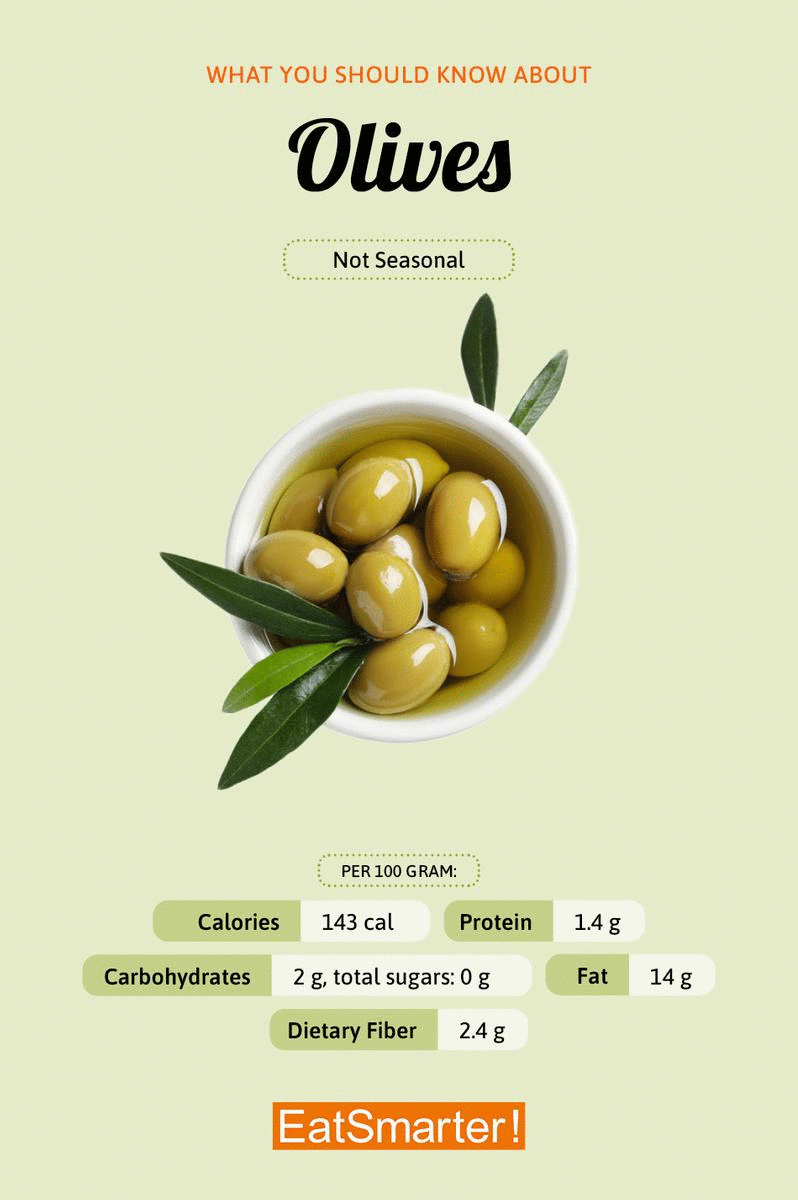Olives
Olives are one of the oldest snack foods in the world, renowned for their taste and powerful nutritional properties. Read up on this centuries-old snack food and its health benefits below.

Olives...
- ...support heart and blood vessel health.The fat contained in olives consists almost exclusively of unsaturated fatty acids, which have a positive influence on both cholesterol levels and the blood pressure.
- ...are good for pregnant women.Olives are rich in folic acid, a B vitamin which can help support baby’s healthy development in the womb.
- ...make a surprisingly good diet snack.Olives might get a bad rep due to their high fat content, however they’re much less caloric than many snack foods, especially the relatively low-calorie green olives, and help keep you full for a long time.
- ...are good for the intestines.Olives are preserved with lactic acid bacteria, which helps support digestion and intestine health.
- ...contain essential vitamins.Both green and black olives contain relatively high amounts of B vitamins, vitamin A and cell-protecting vitamin E.
- ...may help reduce the risk of diabetes.Studies have shown that people who regularly eat olives are less likely to suffer from diabetes. Experts think this is due to the valuable essential fatty acids olives contain.
- ...are best purchased from higher-quality brands.Especially when it comes to black olives, it’s worth a bit more money to purchase a better-quality variety. Black olives gain their color from the long maturation process on the tree, however cheaper brands have been known to artificially color black olives to cut down on the cultivation time, which also decreases the flavor and adds harsh dyes to the mix.
What You Should Know About Olives
In the Mediterranean region, the most well-known cultivator of olives, there are more than 50 different kinds of olives, ranging from very small to relatively large and in colors from light green to dark green to light brown, dark brown and even deep black. For many, the Kalamata - a particularly large, aromatic table olive with a dark blue/black color - is the epitome of an ideal olive. Others prefer the small, completely black olives or appreciate green olives most. Many people think an olive's color dictates what kind it is, but this actually has nothing to do with its variety, but instead its degree of ripeness. Green olives are picked unripe or half-ripe, while fully ripe olives are a dark brown or blue/black. Brownish olives have matured somwhere in the middle, not young but not fully ripe.
After their rather laborious harvest, which is still largely done by hand, olives are given their final touch. Raw, olives taste extremely bitter. In order to make them edible, they are therefore soaked in a brine of either vinegar or oil, often with other flavoring ingredients such as herbs, garlic or chilli. In many countires, most notably Spain, the olives are then de-pitted and stuffed with yummy fillings, from almonds to anchovies.
Origin
The original home of olive trees probably lies in ancient Greece, and the ancient Romans were known to eat olives often.
Season
The harvesting season for fresh olives in Mediterranean countries starts in autumn. However, olives are available loose and packed all year round at the same price.
Flavor
There are big differences in taste between the different kinds of olives. Green olives usually taste somewhat milder and and have a slightly bitter taste, while black olives have a heartier flavor and less of a bitter bite.
How Healthy are Olives?
Olives owe their long shelf life and distinct flavor to the lactic acid bacteria they're brined in, which also has extremely beneficial effects on the stomach and intestines. Above all, olives are rich in extremely healthy unsaturated fatty acids, which are incredibely healthy for the heart and entire cardiovascular system, and can help keep blood fat and cholesterol levels low. That said, olives' high fat content, even though it is healthy, means it is also high in calories. Black varieties are the most calorie-rich, containing 350 calories per 100 g serving. Green olives, on the other hand, contain about 200 calories less per 100 g serving, making them a better option if you're on a diet.
| OLIVE NUTRITIONAL INFO (100 g) | green | black |
|---|---|---|
| Calories | 143 | 350 |
| Protein | 1.4 g | 2.3 g |
| Fat | 14 g | 35 g |
| Carbohydrates | 2 g | 5 g |
| Fiber | 2.4 g | 3.7 g |
Shopping and Cooking Tips
Purchasing
Whether black, green, Kalamata or Mission, most varieties of olives can be purchased at virtually any grocery store. That said, not all olives are made the same, especially when it comes to black olives. Their long maturation process means that cheaper brands tend to pick black olives before they're fully ripe, coloring them with food dyes to reach their optimal color. Therefore, it's best to spring for a higher-quality brand if you can. One surefire way to tell if a black olive is authentic is if it still has its pits, as real black olives are too soft to be pitted.
Storage
Unopened jars or tins of olives can stay fresh in the pantry for many years. Once it's been opened, a jar or can of olives still has a relatively long shelf-life, often staying good for several months as long as its store in the refrigerator.
What to Make With Olives
Olives are a perfect way to add delicious Mediterranean flavor to any number of savory dishes, from pasta, pizza, salads or stews. They're also delicious served as-is with some crackers and cheese, or as a "tapenade" a delicious, easy-to-make dip made from pulverized olives that's popular in the South of France. Simply combine black olives with capers, anchovies, garlic, olive oil and basil in a food processor for a few minutes, salt and pepper to taste, and you have the beautiful and healthy dip ready in a matter of minutes.


















